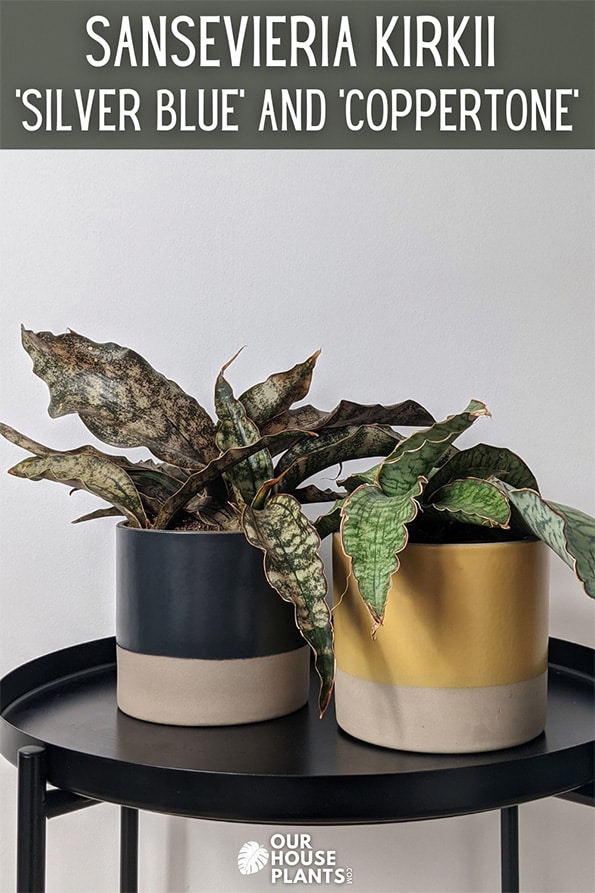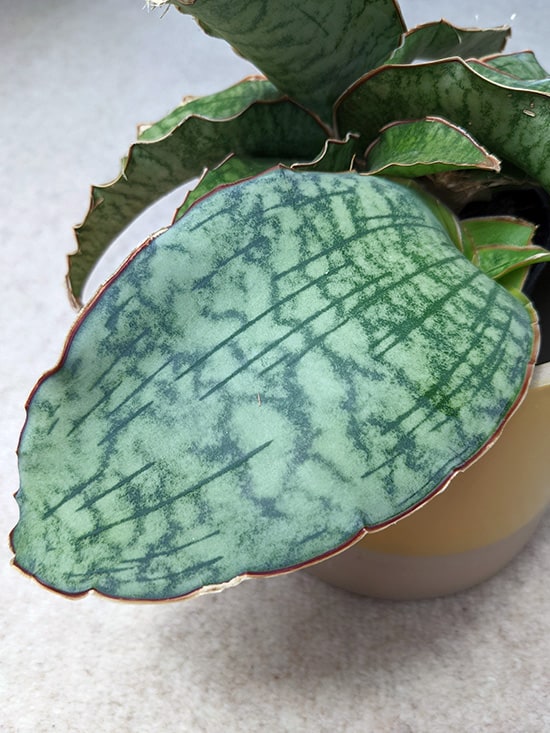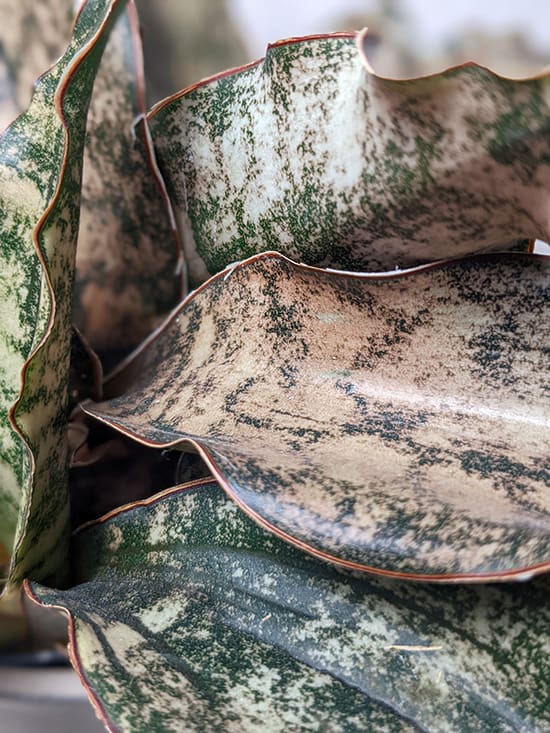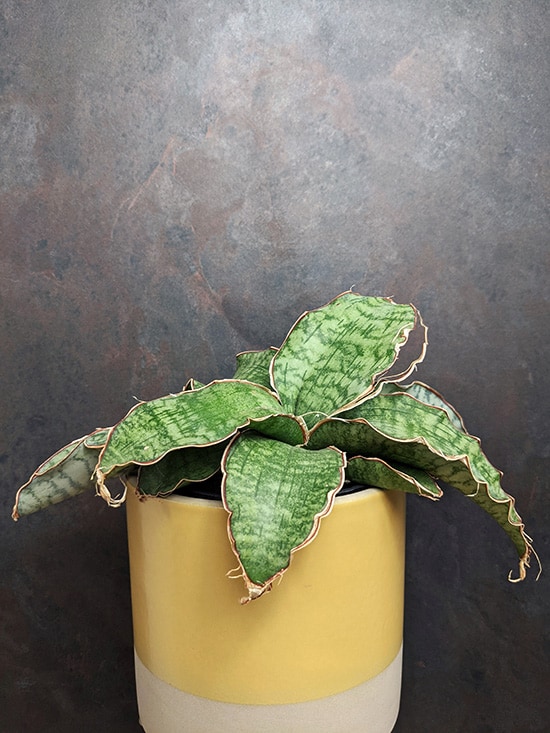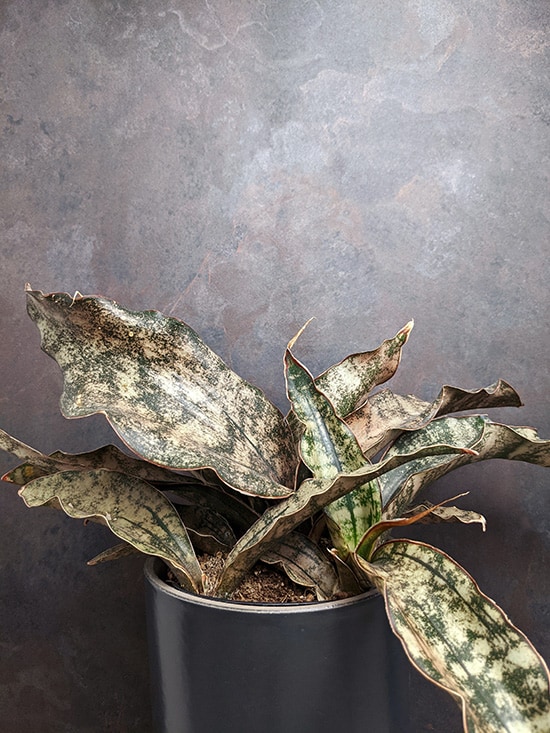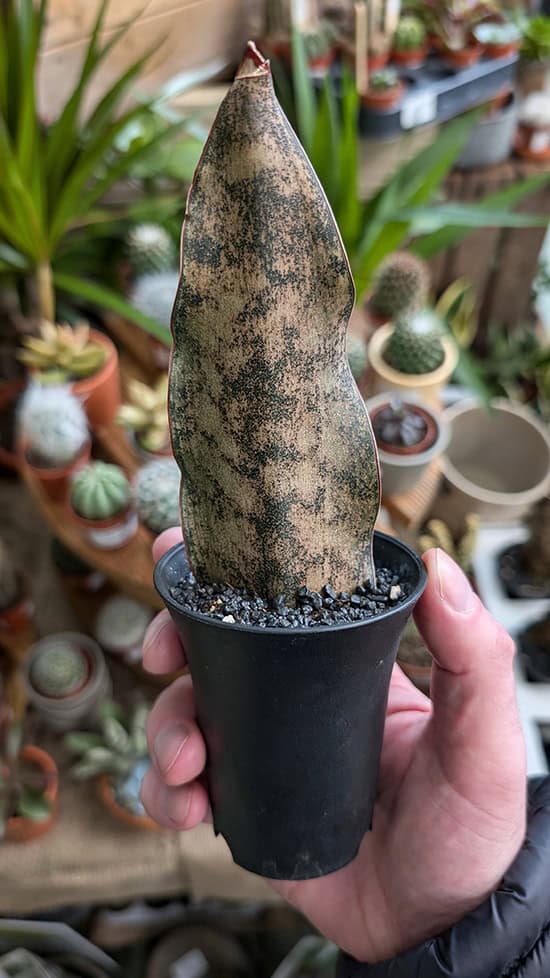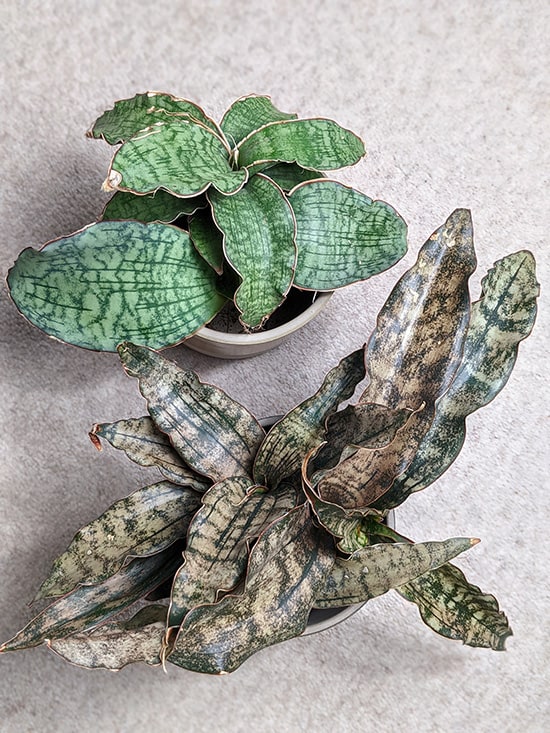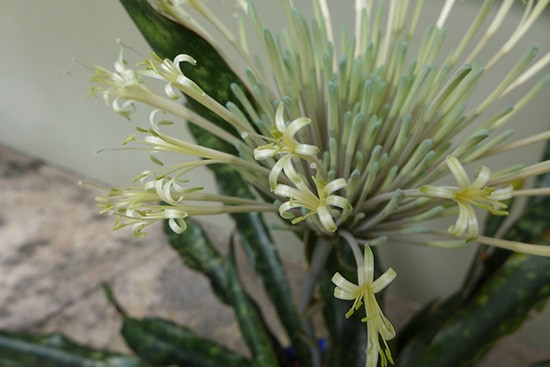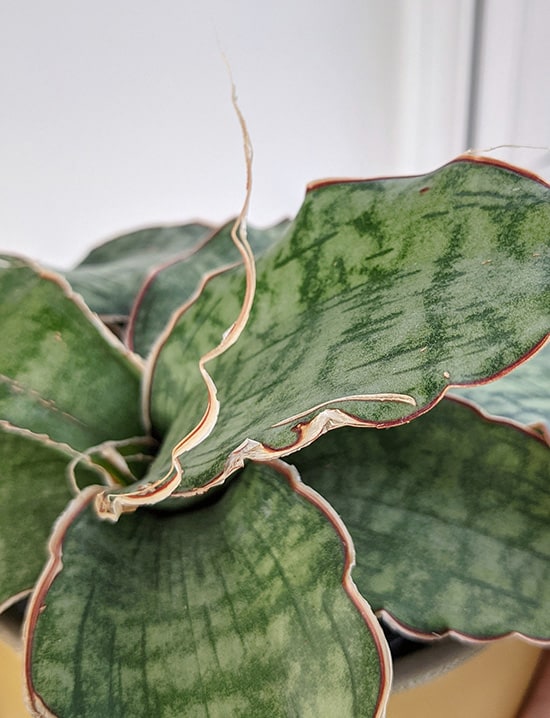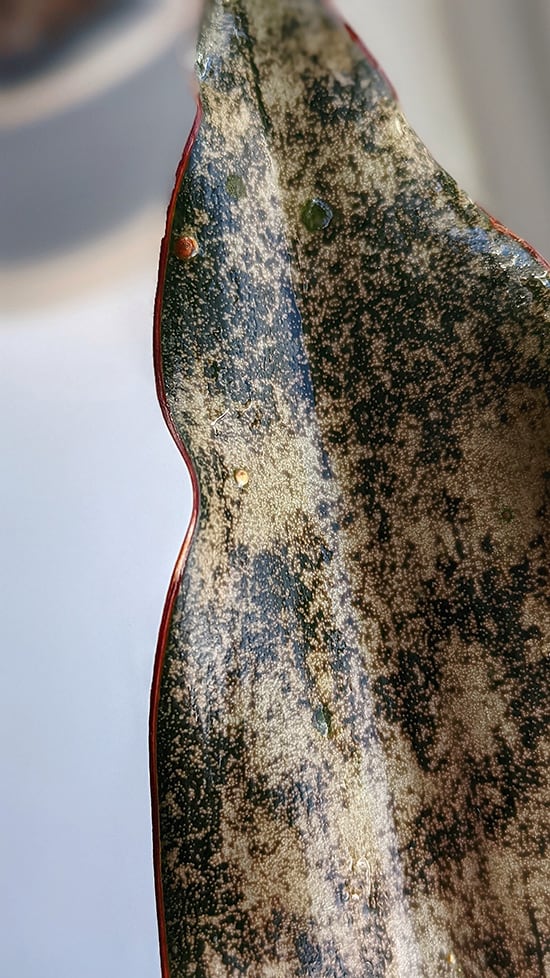If you're a fan of unusual Snake Plants, Sansevieria kirkii 'Silver Blue' and Sansevieria Kirkii 'Coppertone' are certainly worth checking out. Congrats if you've already brought it.
The 'Silver Blue' has slightly silvery blue leaves, whereas the 'Coppertone' variety has deep bronze leaves.
They both posses all the desired qualities from their more famous sibling, the Mother In Laws Tongue. This includes being almost indestructible and easy going houseplants.
The older Botanical name of "Sansevieria kirkii" is typically used for these houseplants. But the correct modern name is "Dracaena pethera var. pulchra".
Another advantage about these particular Snake Plants is that they're not too expensive to buy, even though they're pretty new as houseplants. I'd be surprised if you had to pay a lot more than $20 / £15 for one of these, especially if it was quite a small size.
Common Names
The common name for both of these Snake Plants comes from the colorings on the leaves. I'll explain this a little more below.
They should have "Silver Blue" or "Coppertone" (sometimes this one also goes by the name "Star Canyon Granite") on their labels.
If the botanical Latin name is present you're looking for either "Sansevieria kirkii", or the more modern (and correct) scientific name of "Dracaena pethera var. pulchra".
Although the Silver Blue and Coppertone are by far the most popular, there are a handful of other cultivars and varieties of kirkii that are slowly appearing. The most common is "Cleopatra". It's not expensive either, but it is uncommon and hard to find.
The Silver Blue has a very light sheen of blue on the (very) thick and oval shaped type leaves. This coloring is especially noticeable on new leaves that are less than a year old. I've found that this hue tends to fade as the leaf matures beyond this.
You can see this below: the newish leaf is the largest and up front and the older leaves are in the background, clearly showing the color differences.
This Silver Blue has extremely thick leaves that are edged in a narrow marking of red. The surface has the familiar Snake Plant mottled pattern, but it also has darker longitudinal lines, adding visual interest.
It's an easy going variety providing you give it decent light. I do find though that compared to the Coppertone it suffers from crispy leaf margins more (I cover this in the Problem Section below).
In comparison, the Coppertone has longer and thinner leaves and are a brown or bronze color. Unlike the Silver Blue, mature leaves will maintain and hold onto this coloring well.
They do fade a little though, as you can see below. The central leaf is the newest and this has a slight orange, coppery hue, whereas the other leaves shown in the photo are older and have lost some of this hue over time.
This Coppertone has a tuft of leathery leaves that are a lot thinner and longer than the Silver Blue. The leaves are also edged in red and the markings tend to have different shades of green.
The markings on the leaves are a dark green and look like what you find on other Sansevieria plants. But because so much of the plant is dominated by the bronze, from any sort of distance the plant will look very different to any other Snake Plant out there.
I love how the Coppertone stands out and if you ever get bored of the common green found on the majority of houseplants this gives a really nice pop of something different.

Hi, I'm Tom!
If you're like me and enjoy the challenge of growing houseplants and getting them to thrive, then Ourhouseplants can help. This website shares my knowledge and years of growing plants and provides (hopefully) helpful advice on properly caring for your indoor plant friends.
Snake Plants are known for being able to deal with lower light conditions, which is certainly true. However, there are two reasons why I recommend you try and grow both the Silver Blue and Coppertone in full sunlight or a bright spot with some direct sunlight instead of in a lower lit area.
Firstly the Silver Blue and Coppertone both have light dependent markings. This means they need good light levels to produce and properly show off the silvery blue sheen or the deep attractive, bronze.
Secondly, all Snake Plants will put up with lower light for longer than almost any houseplant, but after a year or two of this they tend to become sickly.
Snake Plants all have average watering needs at best. The Sansevieria kirkii is even more drought tolerant and actually wants to be on the drier side.
Water your plants well and then do not water them again until the potting mix has fully dried out.
Watering Frequency.
Your growing conditions will dictate how often the potting mix will dry out. Mine will differ from yours, so to be able to help you, I need to find a way to tell you what to do based on your own circumstances.
So I created a quick and free watering needs questionnaire. Tell me about your growing conditions and I'll give you some pointers. Super Easy.
This drying out period will change depending on the time of year, and your growing conditions. For example, plants in full sun over the Summer months will need more water than those in lower light, or over the Winter months.
You shouldn't run into any humidity issues unless it's very high. I'm talking bottle garden or terrarium levels, so approaching 90% or higher.
I've seen people saying you should avoid putting them in bathrooms or kitchens. Ignore them. This is rubbish advice. Even if you get close to that 90% level, it will reduce down as soon as the room stops being used. Trust me, your Kirkii's are going to be fine in these places.
The good news is they can be fed infrequently. A minimum of twice a year should be your starting point. If you want to feed more frequently, you can go up to once a month or so.
Use an everyday houseplant feed or you can go specialist with something designed for succulents or cacti.
Dracaena pethera var. pulchra 'Silver Blue' (often called Sansevieria kirkii 'Silver Blue') is a fantastic potted plant to own (if you can find it!).
These are warm loving plants and you'll get the best results if the daytime temperature during the growing seasons gets above 18°C (65°F).
There is no upper temperature that can be found in the average home that should be harmful. Just remember that if the temperature is hot, the potting mix will dry out faster and you may need to water a little more frequently.
Temperatures can be lower over Winter and if this happens the plant will rest until things warm up again in the Spring. But never expose your plant to freezing temperatures. 5°C (41°F) is the lowest I'd risk mine to avoid potential cold damage.
Dracaena pethera var. pulchra 'Coppertone' (often called Sansevieria kirkii 'Coppertone' or 'Star Canyon Granite') has wavy edged margins at the leaf edges that give it a crinkled look. But the leaves are very rigid and hard. This is one tough cookie of a plant.
The roots on both the Silver Blue and Coppertone rarely outgrow their container quickly. Instead, the underground rhizome and leaves will push out to the edges of the pot and create major congestion, blocking the formation of more leaves or offsets.
When this happens (and if you want more leaf growth) move them into a slightly bigger pot.
It's really important that the mix is free draining. I say that about most indoor plants I've owned, but with the Kirkii's I'd step that up a notch and say go for "super free draining".
What potting soil is best for succulents?
I've given a quick summary in this section, but if you want more information then I've got a proper full article waiting for you here.
They really do need open mixes that don't hold large volumes of water. Touching the soil an hour after I've watered mine and it's almost always only damp or moist and that should be the goal to prevent overwatering issues.
Use normal everyday potting soil if you want, but add in at least 50% of a non porous material that will help things drain and stay open. Anything that doesn't hold water such as sharp sand or perlite would be my recommendation.
If you don't fancy mixing things yourself you can always fall back onto a shop brought mix that's designed for succulents. Honestly you can buy this stuff easily from most houseplant shops in person, but if you're a fan of online shopping with reviews or want a broader range of options here is my affiliate link to Amazon with some top picks.
You can also watch my Care Guide for these Snake Plants over on YouTube.
Like all Snake Plants, you can either divide the plant to create more. Or you can propagate with leaf cuttings.
Division.
If you want to divide, you will need a congested and mature-ish plant. Unpot it and you should be able to pull apart the plant. Sometimes this can be done by hand, other times you'll need secateurs or garden snips.
All parts that you want to grow on, should have their own root system, so plan your cuts carefully.
Leaf Cuttings.
A Coppertone propagated by a single leaf cutting. In time pups will emerge from around the base to create a full and bushy plant.
Cut a healthy leaf horizontally (across). You then push this leaf an inch or so into a pot containing a small amount of potting soil, and ideally mix it with sharp sand or some other time of material to help with drainage. (Skip up to potting soil section to better understand this).
The leaf itself will never grow, but it will fuel root growth at the cut edge that you've planted and eventually brand new leaves will pop up around the base.
You should have signs of active growth within two months. This will take longer if the light or temperature is on the low side. Try and do it in the growing season for best results. If the leaf yellows and dies off the attempt has failed.
These Snake Plants have a single rhizome that forms an individual rosette. Over time this will multiply and more underground rhizomes will be created and they will then produce their own leaves, eventually forming a clump.
Each "piece" will only produce one or two leaves during an entire year so the growth rate is considered slow.
But if you have several rhizomes in the same pot you will see more active growth as each part of the clump is then growing their "one or two" leaves, if that makes sense.
These are not very large Snake Plants, but they will spread and create a sizable mound over many years. They will overhang and stretch out from the planter itself, which you can see happening in my photo below.
Silver Blue and Coppertone plants side by side shot from above. They have low-growing rosettes that will eventually spread over the sides of containers.
They really are beautiful plants, especially when contrasted like you can see in the photo. So yes, although they're not tall plants, they'll spread wide. You'll need to have a suitable spot to accommodate this growth style.
In the main, the Kirkii, like all Snake Plants, are brought for their foliage. But with maturity and good care you will get splays of flowers occasionally.
This is often during early or mid-summer but flowering can occur at other points in the year. Although you will only get one period of flowering and then nothing else until the following year.
You'll notice a long thin flowering spike and then blooms will form that open over a period of a month. The scent tends to be strongest in the evening or over night. It has a strong flora Ylang Ylang vibe.
With good care, you may see a flowering stem emerging from the center of the rosette - Photo by Scott Zona
I'm not personally a fan of the flowers in general as the smell is quite strong and it smells funky during the daytime. You can remove them when you see them forming, or simply cut the flowering stem off once they're done.
They can be messy. Eventually the flowers brown up and drop over the plant and a nectar like resin will sometimes ooze that then drips down onto the leaves below or the surrounding furnishings. You can wipe this away easily with a damp cloth.
There is a low level of toxicity running throughout the plant so strictly speaking this is not a pet friendly plant. The good news is that even if large parts of the plant are eaten the effects are usually only moderate. Some vomiting, diarrhea and drooling have all been reported as potential side effects.
Both varieties have thick stiff leaves and this makes them dust magnets. Because the leaves are so large and accessible, its an easy five minute job to wipe them clean with a damp cloth. Try and do this at least once every 6 months.
Crispy Leaf Edges.
Sometimes the leaf margin will brown up and will separate from the main leaf. This can hang off, or just look unsightly.
I've not noticed this on my Coppertone Plants, but unfortunately it seems reasonably common on the Silver Blue. You can see it happening in several places in the photo.
It's easy going and makes an excellent houseplant. But the red margins on the wavy edges of the leaves can be prone to drying up and coming away from the leaf.
I'm still working out why it happens. I suspect it could just be a genetic quirk of the plant or the leaves might be extra sensitive to being knocked and damaged. Either way, you can simply cut off the brown thread-like fibers without harming the plant if you want to tidy things up a little.
Slow Growth.
Most Snake Plants are considered slow growing so it's probably not a problem if you've noticed not much is happening growth wise.
In most cases they seem to sit there for months on end not doing anything, but in reality they're creating and storing energy. Then eventually it's unleashed and the plant will push out a brand new leaf pretty quickly.
Young Kirkii's will only give you one or two leaves every year. Over time the rhizomes under the soil will spread allowing more plants to be created, when this happens you will get more leaves appearing each year.
If you've not had any new growth in over a year, make sure it's not being grown in low light levels or if you do have it in a brightly lit area, consider if a repot might be needed.
Yellow Leaves.
This is going to be one of four things.
Scale Insects.
Few pests affect Snake Plants and most seem to resist sap sucking pests like Aphids and Scale, but for some reason Scale Insects can be an issue on the Sansevieria kirkii. Maybe it tastes nice to them or something.
They can be dealt with by either scrapping off the bugs with a fingernail. Or if that's not your jam, you can use a Q-tip / Cotton Wool Bud, soaked in an alcohol or hydrogen peroxide solution and this should dissolve the insect away.
Brown bumps on the leaves of this Coppertone. The calling card of Scale Insects.
Whether you're growing the Sansevieria kirkii Coppertone or Sansevieria kirkii Silver Blue (or both!), I hope my article has helped you learn how best to grow these plants. If you've got any more care tips or growing hints please do send them my way.
Credit for flowering Sansevieria kirkii to Scott Zona
